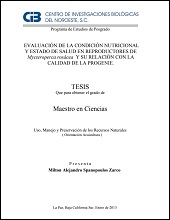Evaluación de la condición nutricional y estado de salud en reproductores de Mycteroperca rosácea y su relación con la calidad de la progenie
Author
MILTON ALEJANDRO SPANOPOULOS ZARCO
Metadata
Show full item recordAbstract
La bioquímica sanguínea y la citometría hemática hoy en día, son herramientas validas
en la determinación de la condición nutricional y el estado de salud de los peces
respectivamente. Con el objetivo de determinar esta condición en reproductores
silvestres de cabrilla sardinera (Mycteroperca rosacea) se determinaron el peso y talla
de 52 reproductores capturados en la localidad de San Evaristo B.C.S. en los meses de
Febrero a Septiembre del 2011 y se les tomó una muestra de sangre con tubos
Vacutainer® mediante punción caudal para realizar una bioquímica sanguínea de 4
parámetros (proteínas, colesterol, triglicérido y lípidos totales) así como una citometría
hemática de 7 parámetros (hemoglobina, hematocrito, eritrocitos, leucocitos, linfocitos,
neutrófilos y plaquetas). Las hembras en estadio vitelogénico cuyo diámetro de huevo
superará las 400μ se indujo al desove por medio de la aplicación de Gonadotropina
Coriónica Humana (GCH) en dos inyecciones, la primera de 1000 UI/Kg de peso
corporal y 24 horas después la segunda de 500 UI/Kg; para el caso de los machos, se
aplico una sola dosis de 500 UI/Kg. A los huevos y larvas obtenidos se les evaluó la
fecundidad y porcentaje de eclosión, se midió el diámetro del huevo, de la gota lipídica,
el tamaño de la larva y del saco vitelino así como un análisis bioquímico de 4
parámetros (Proteínas, triglicéridos, lípidos y colesterol) y un perfil de ácidos grasos. A
los datos obtenidos se les realizaron pruebas de Pearson para encontrar la relación
estadísticas entre los parámetros de reproductores y los de su progenie.
Los resultados evidencian una población de reproductores silvestres sanos, que
responde favorablemente a las demandas metabólicas y citométricas propias del periodo
reproductivo, los valores observados en la bioquímica sanguínea, presentan un pico a la
mitad del ciclo reproductivo coincidiendo con la temporada de desove (Mayo-Junio); a
la par, el sistema inmune, se ve modulado por la temporada de desove, aumentando
significativamente la concentración de linfocitos (60.8x103 cel/mm3) y disminuyendo
los neutrófilos (39.2x103 cel/mm3), como consecuencia de la respuesta del sistema
inmune; las plaquetas y hematocrito por su parte se incrementan significativamente
durante el periodo de desove [...] Blood chemistry and hematic cytometry nowadays are valid tools to determine the
nutritional condition and health status of fish. With the objective of determining the
condition of the wild broodstock of the leopard grouper (Mycteroperca rosacea), we
captured and sized 52 leopard grouper broodstock around the San Evaristo BCS area
from February to September of 2011. Sampled in Vacutainer® tubes by caudal
puncture, we looked for a blood biochemistry of 4 parameters (protein, cholesterol,
triglyceride, and total lipids) and 7 cytometry parameters (hemoglobin, hematocrit,
erythrocytes, leukocytes, lymphocytes, neutrophils and thrombocytes). Vitellogenic
females (egg diameter >400μ) were induced by the application of Human Chorionic
Gonadotropin (HCG) in two doses. The first was 1000 IU / kg per total body weight,
and the second was 24 hours after the first, but reduced to 500 IU / kg. In the case of
males, HCG was applied as a single dose of 500 IU / kg. The eggs and larvae obtained
were evaluated by fertility, hatch rate, measured egg diameter, oil globule diameter, and
size of the larvae and yolk sac. At the same time we also did a biochemical 4 parameter
analysis and fatty acid profile. The data obtained was tested by Pearson to find
statistical correlations between each parameter and their progeny.
The results show a population of healthy wild broodstock, which respond favorably to
the metabolic demands and cytometric in their own reproductive period, the values
observed in blood chemistry, have a peak at the middle of the reproductive cycle
coinciding with the spawning season (May-June); the immune system is modulated by
the spawning season, significantly increasing the concentration of lymphocytes
(60.8x103 cells/mm3) and decreased neutrophils (39.2x103 cells/mm3), as a result of
the response nonspecific immune system, thrombocytes and hematocrit, increase
significantly during the spawning season [...]
Collections
Related items
Showing items related by title, author, creator and subject.
-
PROMOCIÓN DEL PERIFITON PARA EL CULTIVO DE CAMARÓN BLANCO: HACIA UNA ACUICULTURA ECOLÓGICA
DOMENICO VOLTOLINA LOBINA; JUAN MANUEL AUDELO NARANJO; MARIA DEL ROSARIO PACHECO MARGES -
Suelo y Erosión
YOLANDA LOURDES MAYA DELGADO


